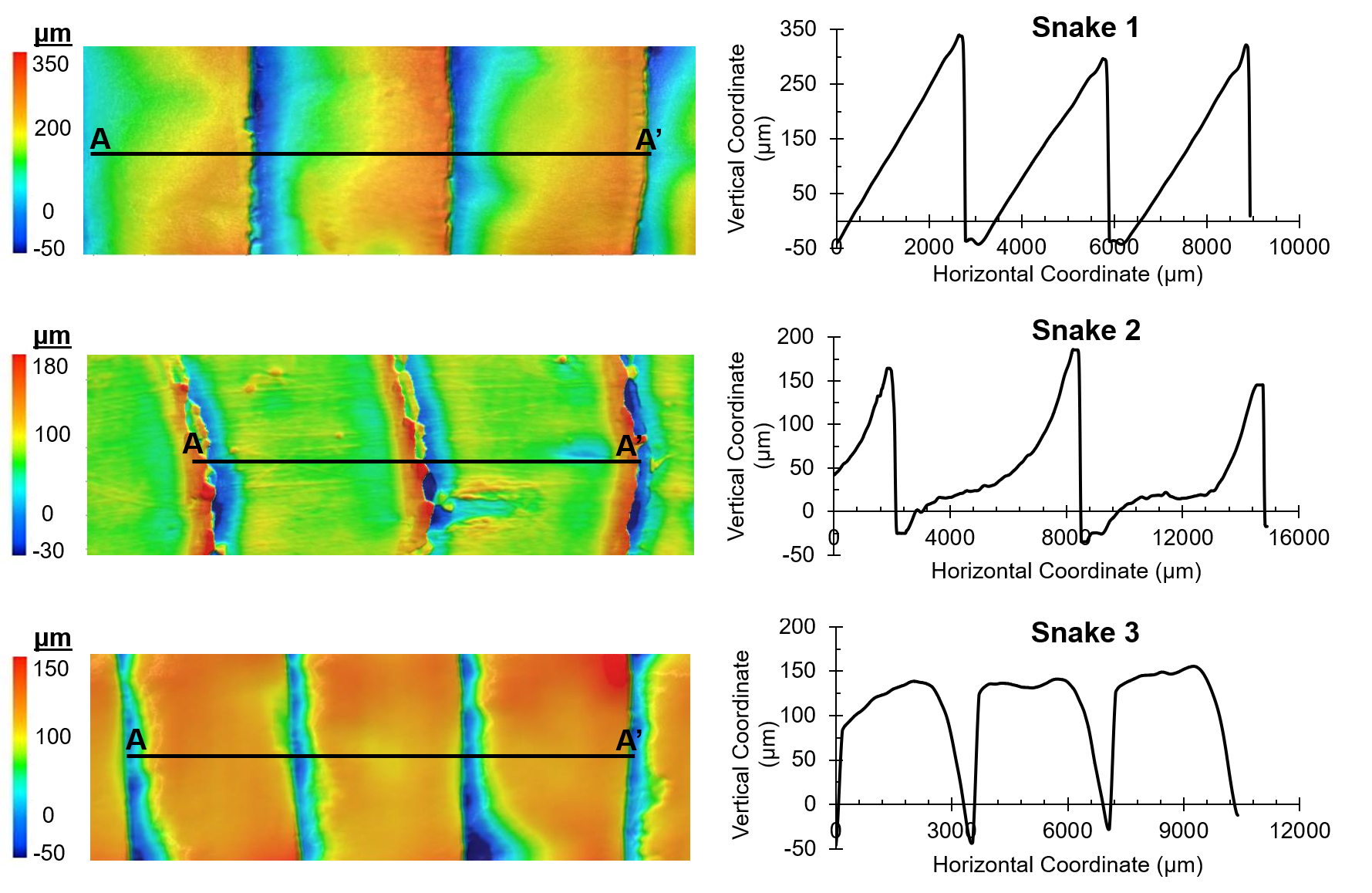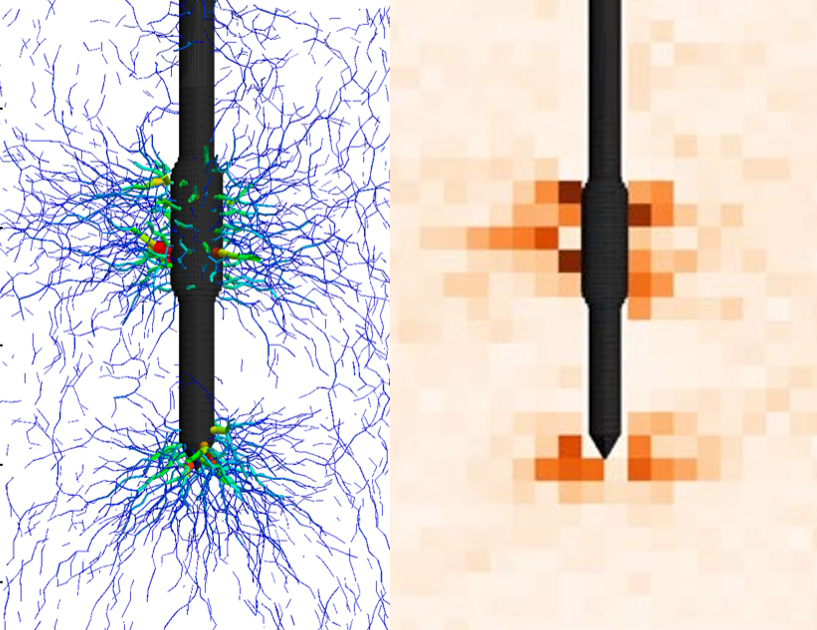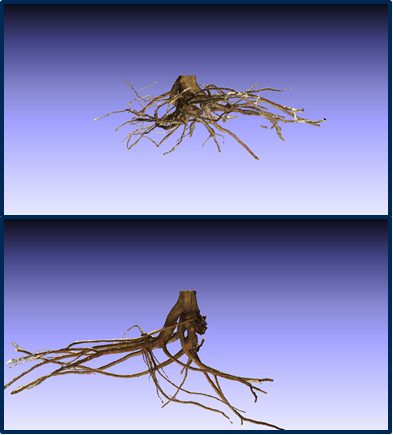Bioinspired Geotechnics
Biological organisms have developed elegant solutions for a variety of needs that are analogous to many engineering problems, such as propulsion for efficient mobility and anchorage to resist wind loads. We study the biological strategies employed by organisms that live in or on the ground to develop bio-inspiration for geotechnical applications such as soil-structure interfaces, soil penetration, and site characterization.
Snakeskin-Inspired Surfaces and Piles
 Surface profiles of three snake species.
Surface profiles of three snake species.
Snakes generate propulsive forces for locomotion while maintaining low friction with the substrate to minimize energy expenditure. The scales on the skin along the underside of the snake compose a surface with frictional anisotropy that mobilizes a larger amount of friction when the substrate is moved against the scales (towards the snake’s head) than when it moves along the scales (towards the snake’s tail). Through laboratory, centrifuge, and field tests and DEM simulations, we have shown that our bio-inspired surfaces and piles mobilize interface shear strengths in monotonic and cyclic loading conditions that are dependent on the direction of displacement relative to the soil (i.e. frictional anisotropy). Our results indicate that implementation of this snakeskin-inspired texturing can enable multifunctionality and increase the efficiency of geotechnical applications such as piles, soil nails, and geomembranes.
Our collaborators on this topic include Prof. Hans Henning Stutz from Karlsruhe Institute of Technology, Prof. Duncan Irschick from UMass Amherst, Dr. Simon Baeckens from Ghent University, and Prof. Brian Todd from UC Davis.
Sponsor:
NSF Center for Biomediated and Bioinspired Geotechnics (CBBG)
Related publications:
•O'Hara and Martinez (2022). Load transfer directionality of snakeskin-inspired piles during installation and pullout in sands. J. Geotech. Geoenv. Eng.
•Martinez and O'Hara (2021). Skin friction directionality in monotonically- and cyclically-loaded bio-inspired piles in sand. DFI J.
•Stutz and Martinez. (2021). Directionally-dependant strength and dilatanvy behavior of soil-structure interfaces. Acta Geotech.
•Martinez et al. (2021). Quantifying surface topography of biological systems from 3D scans. Methods Ecol. Evol.
•O'Hara and Martinez (2020). Monotonic and cyclic frictional anisotropy in snakeskin-inspired surfaces and piles. J. Geotech. Geoenv. Eng.
•Martinez et al. (2019). Bio-Inspiration for anisotropic load transfer at soil-structure interfaces. J. Geotech. Geoenv. Eng.
Bio-Inspired Soil-Burrowing and Penetration
 Force chains and normal stresses around a self-burrowing probe from DEM simulation
Force chains and normal stresses around a self-burrowing probe from DEM simulation
The objective of this project is to improve current subsurface exploration and infrastructure construction technologies by drawing inspiration from the ability of limbless burrowing organisms, such as earthworms, polychaetes, caecilians, tree roots, and clams, to burrow through soil in an efficient manner. Engineers encounter a similar situation while conducting in-situ testing, where a probe equipped with sensors is advanced through soil. Often times, significant challenges are met when in-situ tests are performed on remote locations with little or no accessibility to drill rigs. Our work consists advances the geomechanical understanding of different self-burrowing strategies and evaluates their efficiency and feasibility for application in geotechnical engineering. We are currently performing numerical simulations, experimental tests, and building a field prototype as part of this project.
Our collaborators on this topic include Prof. Jason DeJong from UC Davis, Prof. Raul Fuentes from RWTH Aachen, and Prof. .Jinhyun Cho from KAIST.
Sponsor:
National Science Foundation (NSF)
Center for Information Technology Research in the Interest of Society (CITRIS)
NSF Center for Biomediated and Bioinspired Geotechnics (CBBG)
Related publications:
•Chen et al. (2022), DEM simulations of a bio-inspired site characterization probe with two anchors. Acta Geotech.
•Hunt et al. (2022)Numerical and physical modeling of the effect of cone apex angle on the penetration resistance in coarse-grained soil. Int. J. Geomech.
•Chen et al. (2021), DEM study of the alteration of the stress state in granular media around a bio-inspired probe. Can. Geotech. J.
•Chen et al. (2021), Modeling the self-penetration process of a bio-Inspired probe in granular soils. Bioinsp. Biomim.
•Khosravi et al. (2020). DEM simulations of CPT measurements and soil classification. Can. Geotech. J.
•Martinez et al. (2020). Evaluation of self-penetration potential of a bio-inspired site characterization probe by cavity expansion analysis. Can. Geotech. J.
Root-Inspired Foundations and Anchorage Systems
 3D geometry of root systems subjected to pullout testing, where bottom tree root system mobilized significantly larger loads.
3D geometry of root systems subjected to pullout testing, where bottom tree root system mobilized significantly larger loads.
Tree root systems are remarkably efficient at providing anchorage against complex loads. We are working towards developing knowledge and understanding of the mechanisms that contribute to capacity development of nonlinear or branched foundation systems, such as tree root systems, which could lead to improved sustainability in the arena of foundation design. We are exploring the relationship between root system architecture and force-displacement behavior to better understand how to efficiently develop foundation capacity and demonstrates the potential for improvement in material and energy efficiency compared to pile and footing approaches.
Our collaborators on this topic include Prof. Jason DeJong from UC Davis, Dr. Dan Wilson from the UC Davis Center for Geotechnical Modeling (CGM), and Prof. Tae-Hyuk Kwon from KAIST.
Sponsor:
NSF Center for Biomediated and Bioinspired Geotechnics (CBBG)
Related publications:
•Burrall et al. (2020). Vertical pullout tests of orchard trees for bio-inspired engineering of anchorage and foundation systems. Bioinsp. Biomim.
•Burrall et al. (2019). Dynamics of sequential failure of tree root foundations. EMI 2019.
•Burrall et al. (2018). Vertical pullout tests of tree root systems for bio-inspired foundation idea development. Biomed. Bioinsp. Geotech. Res. Symp.